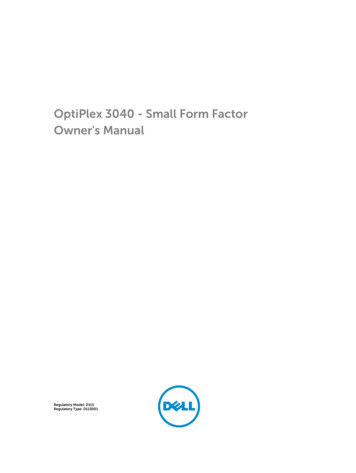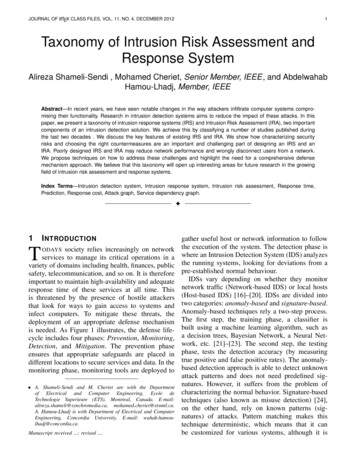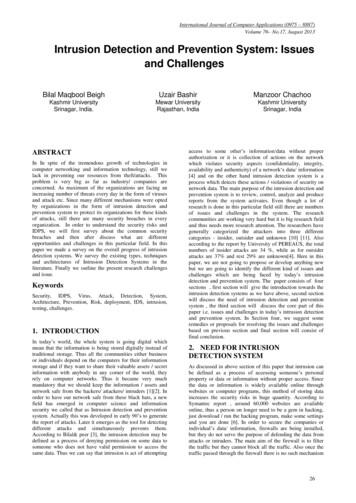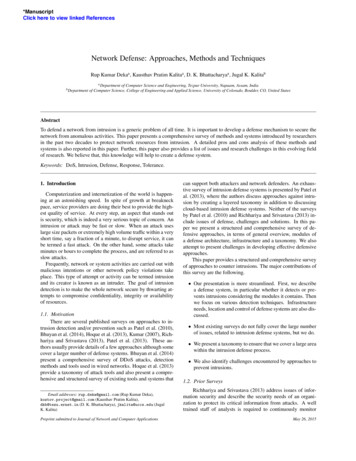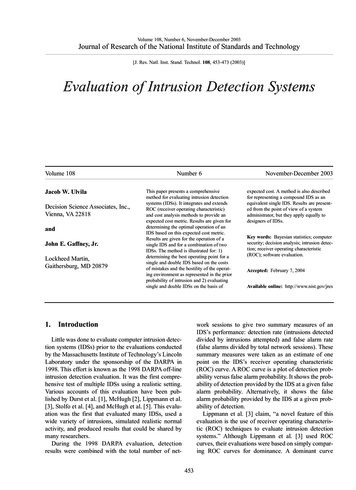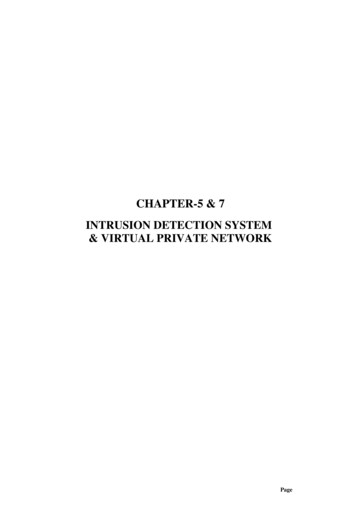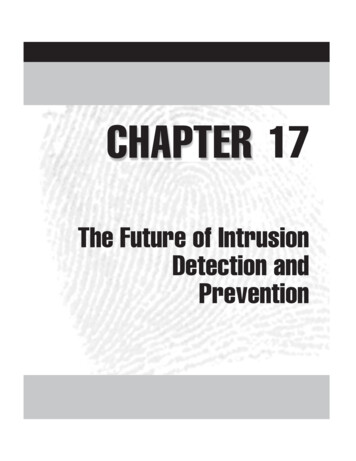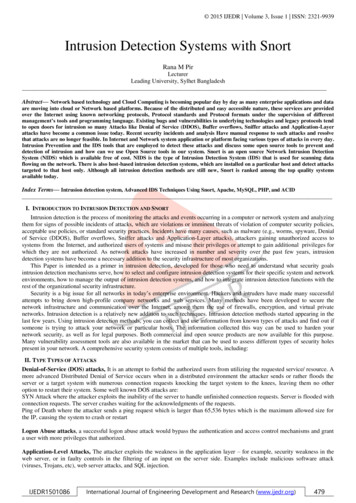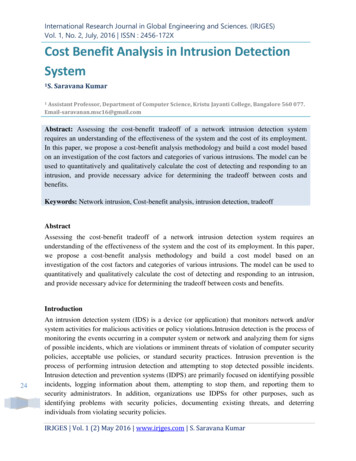
Transcription
International Research Journal in Global Engineering and Sciences. (IRJGES)Vol. 1, No. 2, July, 2016 ISSN : 2456-172XCost Benefit Analysis in Intrusion DetectionSystem1S.Saravana KumarAssistant Professor, Department of Computer Science, Kristu Jayanti College, Bangalore 560 077.Email-saravanan.msc16@gmail.com1Abstract: Assessing the cost-benefit tradeoff of a network intrusion detection systemrequires an understanding of the effectiveness of the system and the cost of its employment.In this paper, we propose a cost-benefit analysis methodology and build a cost model basedon an investigation of the cost factors and categories of various intrusions. The model can beused to quantitatively and qualitatively calculate the cost of detecting and responding to anintrusion, and provide necessary advice for determining the tradeoff between costs andbenefits.Keywords: Network intrusion, Cost-benefit analysis, intrusion detection, tradeoffAbstractAssessing the cost-benefit tradeoff of a network intrusion detection system requires anunderstanding of the effectiveness of the system and the cost of its employment. In this paper,we propose a cost-benefit analysis methodology and build a cost model based on aninvestigation of the cost factors and categories of various intrusions. The model can be used toquantitatively and qualitatively calculate the cost of detecting and responding to an intrusion,and provide necessary advice for determining the tradeoff between costs and benefits.Introduction24An intrusion detection system (IDS) is a device (or application) that monitors network and/orsystem activities for malicious activities or policy violations.Intrusion detection is the process ofmonitoring the events occurring in a computer system or network and analyzing them for signsof possible incidents, which are violations or imminent threats of violation of computer securitypolicies, acceptable use policies, or standard security practices. Intrusion prevention is theprocess of performing intrusion detection and attempting to stop detected possible incidents.Intrusion detection and prevention systems (IDPS) are primarily focused on identifying possibleincidents, logging information about them, attempting to stop them, and reporting them tosecurity administrators. In addition, organizations use IDPSs for other purposes, such asidentifying problems with security policies, documenting existing threats, and deterringindividuals from violating security policies.IRJGES Vol. 1 (2) May 2016 www.irjges.com S. Saravana Kumar
International Research Journal in Global Engineering and Sciences. (IRJGES)Vol. 1, No. 2, July, 2016 ISSN : 2456-172XIDPSs typically record information related to observed events, notify security administrators ofimportant observed events, and produce reports. Many IDPSs can also respond to a detectedthreat by attempting to prevent it from succeeding. They use several response techniques, whichinvolve the IDPS stopping the attack itself, changing the security environment (e.g.,reconfiguring a firewall), or changing the attack’s content.An intrusion detection system (IDS) monitors network traffic and monitors for suspiciousactivity and alerts the system or network administrator. In some cases the IDS may also respondto anomalous or malicious traffic by taking action such as blocking the user or source IP addressfrom accessing the network.InternetIDS Terminology 25 Alert/Alarm- A signal suggesting that a system has been or is being attacked.True Positive- A legitimate attack which triggers an IDS to produce an alarm.False Positive- An event signaling an IDS to produce an alarm when no attack has takenplace.False Negative- A failure of an IDS to detect an actual attack.True Negative- When no attack has taken place and no alarm is raised.Noise- Data or interference that can trigger a false positive.Alarm filtering- The process of categorizing attack alerts produced from an IDS in orderto distinguish false positives from actual attacks.IRJGES Vol. 1 (2) May 2016 www.irjges.com S. Saravana Kumar
International Research Journal in Global Engineering and Sciences. (IRJGES)Vol. 1, No. 2, July, 2016 ISSN : 2456-172XTypes of Intrusion-Detection systemsThere are two main types of IDS's: network-based and host-based IDS.In a network-based intrusion-detection system (NIDS), the sensors are located at choke pointsin network to be monitored, often in the demilitarized zone (DMZ) or at network borders. Thesensor captures all network traffic and analyzes the content of individual packets for malicioustraffic.In a host-based system, the sensor usually consists of a software agent, which monitors allactivity of the host on which it is installed, including file system, logs and the kernel. Someapplication-based IDS are also part of this category.Network intrusion detection system (NIDS)Network Intrusion Detection Systems gain access to network traffic by connecting to a hub,network switch configured for port mirroring, or network tap. An example of a NIDS is Snort.Network Intrusion Detection Systems are placed at a strategic point or points within the networkto monitor traffic to and from all devices on the network. Ideally you would scan all inboundand outbound traffic, however doing so might create a bottleneck that would impair the overallspeed of the network.Host-based intrusion detection system (HIDS)It consists of an agent on a host that identifies intrusions by analyzing system calls, applicationlogs, file-system modifications (binaries, password files, capability/acl databases) and other hostactivities and state. An example of a HIDS is OSSEC.Host Intrusion Detection Systems are run on individual hosts or devices on the network. AHIDS monitors the inbound and outbound packets from the device only and will alert the useror administrator of suspicious activity is detected.Requirements in Traditional Intuition Detection System (TIDS)In general, an TIDS has the following requirements:26–Detection of known attacks. This is the IDSs basic functionality. An IDS should have theability to determine the malicious attackers who want to intrude the systems in the past andare likely to occur in the future.IRJGES Vol. 1 (2) May 2016 www.irjges.com S. Saravana Kumar
International Research Journal in Global Engineering and Sciences. (IRJGES)Vol. 1, No. 2, July, 2016 ISSN : 2456-172X–––Real-time/near real-time analysis. An IDS should analyze information sources gathered bythe IDS sensor as soon as possible. Before an attacker significantly damages the systems,the IDS can perform the real-time/near real-time analysis.Minimal resource. IDSs should use the minimal resource in the systems when monitoring.For example, in HIDSs, the minimal resource could avoid the lack of the systems’ recourse.In NIDSs, minimal resource could avoid the IDSs crash by themselves.High accuracy. IDSs should make sure the detection is correct and lower the false alarmsCost Analysis of TIDSThe damage cost (DCost), is the cost of damage caused by hackers when IDSs do not workappropriately.Response cost (RCost), means the costs of actions when response components generate alarms,including active (automatic) and passive (manual) responses.Operational cost (OpCost) is the cost of processing and analyzing the activities of events. It iscorresponding to the target computing resource.False Negative cost is the cost of not detecting an attack, but an attack really happened.Therefore, this cost is defined as the damage cost associated with event.False Positive cost occurs when normal behavior is misidentified as the attack. If RCost is lessthan DCost, a response will ensue and the response cost must be accounted for as well. If RCostis great or equal than DCost, the minimal cost is that SMs do not responded to this intrusion.Then FP cost is zero.True Positive cost means the detection cost when attacks really happen.If Rcost is greater or equal than DCost, the minimal cost is that SMs do not responded to thisintrusion, and the loss is DCost. Otherwise, If RCost is less than DCost, an attack is detectedand response ensues, some damage may have incurred. TP cost may be defined as Rcost Є1DCost, here Є 1 is the function of the events’ progress belongs to interval between 0 and 1.27True Negative is incurred when an IDS correctly decides there are no attacks. This cost isalways zero since no attacks happen.IRJGES Vol. 1 (2) May 2016 www.irjges.com S. Saravana Kumar
International Research Journal in Global Engineering and Sciences. (IRJGES)Vol. 1, No. 2, July, 2016 ISSN : 2456-172XCost(E) (CCos(e) OpCos(e))Cumulative Eette E(the event set)Roles in Intrusion Detection System with Identification Capability (IDSIC)In TIDSs, most designers only discuss three roles: hackers, SMs, and DS, but in a large systemwith high security environment, it always includes system security auditors to perform sometests to keep a check on system vulnerability.The security auditor (SA) can be defined as a person appointed and authorized to audit whetherthe security equipments work regularly or not by using the vulnerability testing tools. One ofsecurity auditors’ main works is to check the security holes or vulnerabilities in the system.Note that in traditional IDSs, they have no abilities to distinguish the security auditors andhackers.Detection System with Identification Capability (DSIC) is defined as One type of DS that runsthe same function of DS. However, it has an extra functionality to distinguish between the rolesof hackers and SAs.In order to distinguish SAs and hackers, we will define the fingerprint first. The fingerprint issome secret information is used to let DSIC distinguish the difference between hackers andSAs.Cost Analysis in IDSICThe damage cost (DCost) should be divided into two parts; hackers’ and SAs’ damage cost.––28––The term HDCost(e) means the damage cost caused by hackers that may harm to thesystems.The cost of SAs, SDCost(e), is the amount of security testing cost that may damage to thesystems.The HDCost is much greater than SDCcost since SAs do not want to harm to the system, buthackers do.Similarly, the response cost (RCost) will also be separated into two parts: the cost ofresponse generated by hackers (HRCost) and the one created by SAs (SRCost).IRJGES Vol. 1 (2) May 2016 www.irjges.com S. Saravana Kumar
International Research Journal in Global Engineering and Sciences. (IRJGES)Vol. 1, No. 2, July, 2016 ISSN : 2456-172X–The HRCost will be similar with SRCost since hackers and SAs use the same tools.False Negative (FNIC)FNIC HDCost (e) 2SDCost (e), 0 2 1False Positive (FPIC) RCost(e ) FPIC 0 if DCost(e ) RCost(e )if DCost(e ) RCost(e )Cumulative Cost (E ) (ICCost (e) OpCost (e))e E–OpCost(e) is similar in TIDS and IDSIC–CCost(e) in TIDS is greater than ICCost(e) in IDSIC–IDSIC could have smaller CumulativeCost(E) than TIDS.The purpose of the cost-benefit analysis is to periodically review the effectiveness of plannedand implemented security controls to determine if they are doing what they are supposed to do,rather than creating additional vulnerabilities. It is used to support the management and controlactions.ConclusionThe research objectives of this paper were quantitative and qualitative analysis of the securityrisks in a distributed network environment, creation of a cost model, and determination of thecost-benefit tradeoff of a network intrusion detection system.We propose a new model, IDSIC, based on the auditing point of view and propose the newrequirements in IDSIC.We prove the CumulativeCost in TIDS does not reach to minimal cost under the roles of SAexists.29References[1] R. Summers, Secure Computing, McGraw-Hill, 1997.[2] C.Pfeleeger, security computing, Prentice-Hall, Inc, 1997.IRJGES Vol. 1 (2) May 2016 www.irjges.com S. Saravana Kumar
International Research Journal in Global Engineering and Sciences. (IRJGES)Vol. 1, No. 2, July, 2016 ISSN : 2456-172X[3] Cost-Benefit Analysis Guide for NIH IP Project, www.itpolicy.gsa.giv[4] Dunigan, Hinkel “Intrusion detection and intrusion prevention on a large network, a casestudy”, 1999.[5] Lee, Miller, et al. “Toward cost sensitive modeling for intrusion detection”[6] Proctor, “The Practical Intrusion Detection Handbook”, 2001[7] Richards, Network Based Intrusion Detection: a review of technologies, 1999[8] Tites et.al. Information systems Security , 1993[9] Hummer et.al. “A Cooperative, Collaborative Intrusion Detection System”.[10] Lunt, A survey of intrusion detection techniques, 1993.30IRJGES Vol. 1 (2) May 2016 www.irjges.com S. Saravana Kumar
Cost Benefit Analysis in Intrusion Detection System 1S. Saravana Kumar 1 Assistant Professor, Department of Computer Science, Kristu Jayanti College, Bangalore 560 077. Email-saravanan.msc16@gmail.com Abstract: Assessing the cost-benefit tradeoff of a network intrusion detection system

